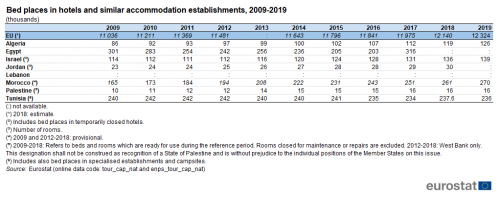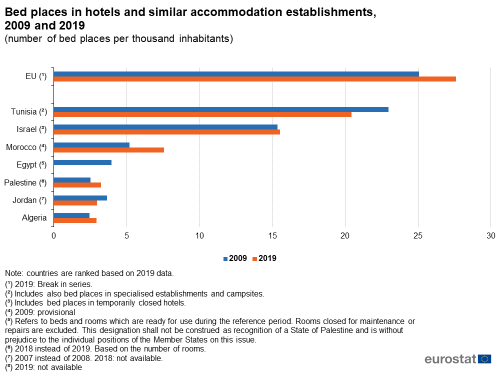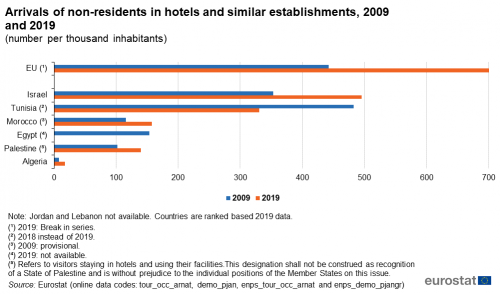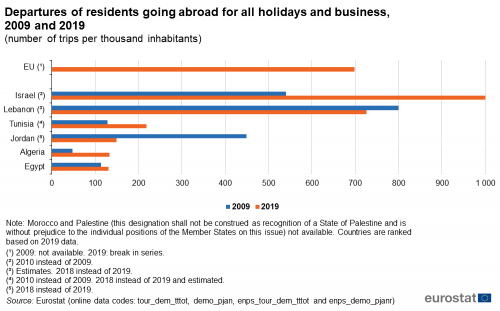Archive:European Neighbourhood Policy - South - tourism statistics
Data extracted in June 2021.
Planned article update: March 2022.
Highlights
In 2019, the number of bed places in reporting European Neighbourhood Policy-South countries was 270 thousand in Morocco, the highest in the region.
Among the European Neighbourhood Policy-South countries, non-resident arrivals in hotels and similar accommodation establishments almost trebled in Algeria between 2009 and 2019.
More than 1 trip per inhabitant was taken abroad for all holidays and business by residents from Israel in 2019.
Arrivals of non-residents in hotels and similar establishments, 2009 and 2019
This article is part of an online publication and presents information relating to tourism in the European Union (EU) and eight of the ten countries that form the European Neighbourhood Policy-South (ENP-South) region — Algeria, Egypt, Israel, Jordan, Lebanon, Morocco, Palestine [1] and Tunisia; no recent data are available for Libya or Syria. It highlights recent developments over the period 2009-2019, with information on capacity (the number of bed places) and international demand (the number of arrivals of non-residents at hotels and similar accommodation) for inbound tourism, as well as information on the number of outbound trips made by tourists.
Full article
Tourism infrastructure
The number of bed places available in hotels and similar accommodation establishments as presented in Table 1 provides a measure of a country’s capacity to attract tourists; note that official tourism statistics include business travellers as tourists alongside individuals travelling for pleasure or other reasons.

(thousands)
Source: Eurostat (tour_cap_nat) and (enps_tour_cap_nat)
Among the ENP-South countries for which data are available, Egypt reported the highest number of bed places in hotels and similar accommodation establishments with 316 thousand in 2017 (no more recent data available), resulting to an average annual growth rate of 0.6 % since 2009. In 2019, Morocco recorded 270 thousand bed places in hotels and similar accommodation establishments, a 5.0 % annual average growth over the decade. Tunisia accounted for 236 thousand number of bed places in 2019. Tunisia was the only country to report an average annual decline from 2009 to 2019 (down 0.2 %). In Israel and Algeria there were 139 thousand and 126 thousand bed places respectively in 2019, corresponding to average annual growths of 2.0 % and 3.8 % respectively over the decade. The lowest levels of capacity were recorded for Jordan with 30 thousand (note the data refer to numbers of rooms; 2018 data) and Palestine, with 16 thousand in 2019. When comparing to 2009, Jordan reported an annual average growth of 3.0 % and Palestine 5.0 %. No data was available for Lebanon. With its total of 12.3 million bed places in 2019, the EU showed a 1.1 % average annual growth since 2009.
Figure 1 presents another measure for analysing the number of bed places in hotels and similar establishments, providing information in relation to the size of the national population. Out of the seven ENP-South countries illustrated (no data available for Lebanon), Tunisia reported the highest number of bed places per 1 000 inhabitants both in 2009 and 2019, note that this value also includes bed places in specialised establishments and campsites. However, it reported a decrease to 20.4 bed places in 2019 from 23.0 bed places per 1 000 inhabitants in 2009. Israel number of bed places was rather constant over the decade, with 15.5 bed places per 1 000 inhabitants in 2019 and 15.4 bed places per 1 000 inhabitants in 2009, knowing that these numbers also include bed places in temporarily closed hotels. Morocco displayed the highest increase in bed places over the 10-year period, reaching 7.6 bed places per 1 000 inhabitants in 2019, from 5.2 bed places per 1 000 inhabitants in 2009. Egypt’s data was not available for 2019 but in 2009, it had 4.0 bed places per 1 000 inhabitants. An increase in bed places was also recorded in Palestine and Algeria, where both countries had 2.5 bed places per 1 000 inhabitants in 2009 and grew to 3.3 bed places per 1 000 inhabitants and 2.9 bed places respectively in 2019. Jordan was one of two countries (with Tunisia) that decreased its number of bed places per inhabitants, offering 3.7 bed places per 1 000 inhabitants in 2009 but only 3.0 in 2018 (no 2019 data available). It is important to note that the figures for Jordan are based on the number of rooms. The EU recorded a higher capacity of bed places than any of the ENP-South countries, with 27.6 bed places in hotels and similar accommodation establishments per 1 000 inhabitants in 2019.

(number of bed places per thousand inhabitants)
Source: Eurostat (tour_cap_nat), (demo_pjan), (enps_tour_cap_nat) and (enps_demo_pjangr)
Non-resident arrivals
Figure 2 presents the number of arrivals of non-residents in hotels and similar accommodation establishments across the ENP-South countries and the EU, according to their respective population sizes and according to data availability. Recent data for Jordan and Lebanon is not available. The largest number of arrivals of non-residents in hotels and similar establishments in 2019 was recorded by Israel, with 495 non-residents per 1 000 inhabitants. Tunisia had the second largest number of arrivals among the ENP-South countries, 331 per 1 000 inhabitants (2018 data), while Morocco recorded less than half of that, with 158 non-residents arrivals per 1 000 inhabitants. Data for 2019 was not available in Egypt but in 2009, it had 153 non-residents arrivals. In Palestine, 140 non-residents per 1 000 inhabitants arrived in hotels and similar establishments in 2019 and only 18 in Algeria. These figures can be compared with a total of 709 arrivals of non-residents at hotels and similar accommodation establishments in the EU in 2019. Among the ENP-South countries, the ratio of non-resident arrivals in hotels and similar establishments to population was systematically lower than in the EU. Between 2009 and 2019, there were increases in non-residents arrivals per thousand inhabitants in all ENP-South countries for which data is available, with the exception of Tunisia. Arrivals of non-residents in hotels and similar establishments more than doubled in Algeria (120.4 % increase). Non-resident arrivals also increased by 40.2 % in Israel, 37.0 % in Palestine and 36.5 % in Morocco, while this number declined by 31.5 % in Tunisia. In comparison, there was an increase by 60.2 % in the EU. It has to be noted that there was a break in series in the EU data in 2019.

(number per thousand inhabitants)
Source: Eurostat (tour_occ_arnat), (demo_pjan), (enps_tour_occ_arnat) and (enps_demo_pjangr)
Table 2 shows the development of the number of arrivals of non-residents staying in hotels and similar accommodation establishments during the period 2009-2019. By far the strongest increase (in percentage terms) was recorded for Algeria, where the number of arrivals more than doubled (169.6 %)), from 284 thousand in 2009 to 766 thousand in 2019. Although less spectacular, the increase in the number of non-resident arrivals in Palestine was also high (74 %). In 2019, 688 thousand non-residents arrived in Palestine, compared to 396 thousand in 2009. In Israel, there was an increase of 69.4 % between 2009 and 2019 in the number of arrivals of non-residents, from 2.6 million to 4.4 million. In Morocco, the latest data in 2019 were 52.8 % (5.6 million arrivals) higher than in 2009 (3.7 million arrivals). In Tunisia, the number of non-resident arrivals fell most years, most notably in 2011 and 2015, most probably a consequence of the Arabic Spring in 2011 and the terrorist attack close to Sousse in June 2015. The level of Tunisia’s arrivals of non-residents staying in hotels and similar accommodation establishments in 2019 was 11 % lower than in 2009. Although a time series after 2014 is not available for Egypt, the information that is available highlights the impact of political turmoil in recent years: in 2009, the number of non-resident arrivals in Egypt was 11.7 million, but was less than half this level (6.3 million) by 2013, although in 2014 growth returned as the number of arrivals was up to 7.4 million. No data in available for Jordan and Lebanon over the studied period. In comparison, 316.4 million non-residents arrived and stayed in hotels and similar accommodation establishments in 2019 in the EU, while a decade earlier this number was 194.6 million; hence a 62.6 % increase.

(thousands)
Source: Eurostat (tour_occ_arnat) and (enps_tour_occ_arnat)
Outbound tourism
This final section details the outward flow of tourists travelling abroad. Table 3 presents the number of trips made by tourists from ENP-South to destinations outside of their own country for the period 2009-2019. For the EU, the figures represent the number of trips made by EU tourists to destinations outside of their own Member State. Note that EU data for this particular indicator only refer to persons aged 15 and more.

(thousands of trips)
Source: Eurostat (tour_dem_tttot) and (enps_tour_dem_tttot)
Among the ENP-South countries for which data are available, the highest number of outbound trips taken by tourists was recorded for Egypt at 12.8 million in 2019, while there were almost 48.5 % less trips in 2009 (8.6 million). Israel reported the second highest number of trips both in 2019 (9.2 million) and 2009 (4.0 million) and in. The number of trips, therefore, more than doubled over that period. The highest growth was found in Algeria, where number of trips more than trebled in a decade, with 5.7 million trips of residents going abroad in 2019 and 1.7 million in 2009. In Lebanon, 3.8 million trips were taken by residents in 2019 and 3.0 million in 2009 (up 23.9 %). Tunisia’s data was not available for 2009 and between 2012 and 2015, however, the number of trips doubled between 2010 (1.4 million) and 2019 (2.8 million). Jordan had a short time series and is the only country, where data is available, to show a decline (by 48.5 %) in the number of trips taken by residents; 2.9 million trips in 2010 to 1.5 in 2018. Morocco and Palestine did not have any available data on the departures of residents travelling abroad for holidays and business. In the EU, 311.4 million trips were taken in 2019, which is an increase of 29.5 % compared to 2012 (no data available for the period 2009-2011).
Figure 3 illustrates departures of residents, according to the size of the different populations. Again, data were not available for Morocco and Palestine. In 2019, Israel had the most departures of residents going abroad for all holidays and business (1 023 trips per thousand inhabitants) with regards to its population. In 2010 (no data for 2009), the number of trips taken was 540 per thousand inhabitants and increased by 89.6 %. Lebanon followed with 726 trips of residents per thousand inhabitants in 2018 (no data for 2019), which decreased compared to 2009 when it was 800 % trips per thousand inhabitants (down 9.2 %). In Tunisia, the number of trips taken by residents per inhabitants grew by over two thirds (up 69.3 %), from 129 trips per thousand inhabitants in 2010 (no 2009 data) to 218 trips per thousand inhabitants in 2018 (no 2019 data). In contrast, the trips per inhabitants declined in Jordan by two third (down 66.8 %) from 449 trips per thousand inhabitants in 2009 to 149 trips per thousand inhabitants in 2018 (no 2019 data). Algeria recorded the strongest overall growth with its number of outbound resident trips per inhabitants almost trebling (up 179.5 %) between 2009 and 2019. There were 133 trips abroad per thousand inhabitants in 2019, while a decade earlier they were taking 48 trips per inhabitants. Finally, Egypt also reported a growth in outbound trips per inhabitants such that the figure in 2019 (131 trips per thousand inhabitants) was 15.4 % than in 2009 (113 trips per thousand inhabitants).

(number of trips per thousand inhabitants)
Source: Eurostat (tour_dem_tttot), (demo_pjan), (enps_tour_dem_tttot) and (enps_demo_pjanr)
Source data for tables and graphs
Data sources
Tourism, in a statistical context, refers to the activity of visitors taking a trip to a destination outside their usual environment, for less than a year. It can be for any main purpose, including business, leisure or other personal reasons other than to be employed in the place visited. A tourist is a visitor that stays overnight (at least one night).
Within the EU, a system of tourism statistics was established through Council Directive 95/57/EC of 23 November 1995 on the collection of statistical information in the field of tourism. This legal basis requires EU Member States to provide a regular set of comparable tourism statistics. The Directive was amended in 2004 and 2006, before being repealed in 2011 when the European Parliament and the Council of the European Union adopted Regulation (EU) No 692/2011 concerning European statistics on tourism. The 2011 Regulation on tourism statistics was amended in 2013, in 2019 and again in 2020; the current consolidated version of Regulation (EU) No 692/2011 incorporate all these amendments.
Tourism statistics in the EU consist of two main components: on the one hand, statistics relating to capacity and occupancy (supply-side tourism statistics); on the other, statistics relating to tourism demand. In most EU Member States, the former are collected via surveys filled in by accommodation establishments, while the latter are mainly collected via traveller surveys at border crossings or through household surveys. Statistics on tourism demand refer to tourist participation, in other words, trips of at least one overnight stay during the reference period.
The data for ENP-South countries are supplied by and under the responsibility of the national statistical authorities of each country on a voluntary basis. The data that are presented in this article result from an annual data collection cycle that has been established by Eurostat. No recent data are available from either Libya or Syria. These statistics are available free-of-charge on Eurostat’s website, together with a range of different indicators covering most socio-economic areas.
Tables in this article use the following notation:
| Value in italics | data value is forecasted, provisional or estimated and is therefore likely to change; |
| : | not available, confidential or unreliable value; |
| – | not applicable. |
Context
Tourism has the potential to contribute towards employment and economic growth, as well as to development in rural, peripheral or less-developed areas. Infrastructure created for tourism purposes contributes to local development, while jobs that are created or maintained can help counteract industrial or rural decline. Sustainable tourism involves the preservation and enhancement of cultural and natural heritage, ranging from the arts to local gastronomy or the preservation of biodiversity.
The European Neighbourhood Policy (ENP), launched in 2004, supports and fosters stability, security and prosperity in the EU’s neighbourhood. The ENP was revised in 2015. The main principles of the revised policy are a tailored approach to partner countries; flexibility; joint ownership; greater involvement of EU member states and shared responsibility. The ENP aims to deepen engagement with civil society and social partners. It offers partner countries greater access to the EU's market and regulatory framework, standards and internal agencies and programmes.
The Joint Communication by the European External Action Service and the European Commission on Renewed Partnership with the Southern Neighbourhood, accompanied by an EU Economic and Investment Plan for our Southern Neighbours, of 9 February 2021 further strengthens cooperation with the ENP-South countries.
The main objective of Euro-Mediterranean cooperation in statistics is to enable the production and dissemination of reliable and comparable data, in line with European and international norms and standards.
Reliable and comparable data are essential for evidence-based decision-making. They are needed to monitor the implementation of the agreements between the EU and the ENP-South countries, the impact of policy interventions and the reaching of the Sustainable Development Goals (SDGs).
The EU has been supporting statistical capacity building in the region for a number of years through bilateral and regional capacity-building. This takes the form of technical assistance to partner countries’ national statistical authorities through targeted assistance programmes and activities such as training courses, working groups and workshops, exchange of best practice and the transfer of statistical know-how. Additional information on the policy context of the ENP is provided here.
Notes
- ↑ This designation shall not be construed as recognition of a State of Palestine and is without prejudice to the individual positions of the Member States on this issue.
Direct access to
Books
Leaflets
- Basic figures on the European Neighbourhood Policy — South countries — 2019 edition
- Basic figures on the European Neighbourhood Policy — South countries — 2018 edition
- Basic figures on the European Neighbourhood Policy — South countries — 2016 edition
- Basic figures on the European Neighbourhood Policy — South countries — 2015 edition
- Tourism statistics for the European Neighbourhood Policy — South countries — 2019 edition
- Tourism (med_to)
- Main flows (med_to11)
- Arrivals by type of accommodation (med_to12)
- Nights spent by type of accommodation (med_to13)
- Accommodation establishments (med_to21)
- Number of bed-places (med_to22)
- Tourism (tour), see:
- Monthly data on tourism industries (tour_indm)
- Annual data on tourism industries (tour_inda)
- Annual data on trips of EU residents (tour_dem)
- Southern European Neighbourhood Policy countries (ENP-South) (med) (ESMS metadata file — med_esms)
- Annual data on trips of EU residents (ESMS metadata file — tour_dem_esms)
- Occupancy of tourist accommodation establishments (ESMS metadata file — tour_occ_esms)
- Methodological manual for tourism statistics — Version 2.1 — 2013 edition